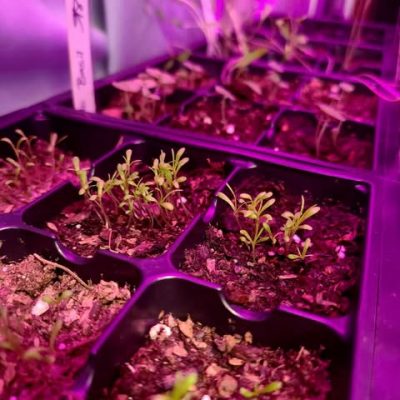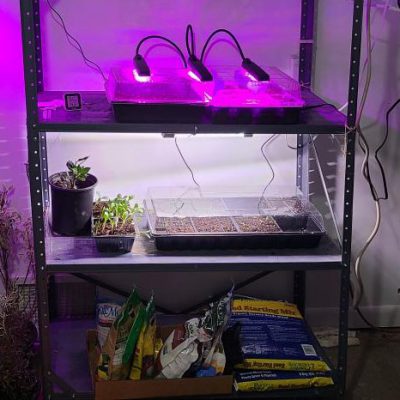By Emily Leahy, UConn Home & Garden Education Center

The dead of winter brings a longing to spend time outside in the garden again. While this may not be possible yet, it is easy to craft your own growing space indoors. The elements of the outdoors that allow plants to thrive – light, warmth, and water – can all be brought indoors with a little creativity and the right resources.
Some steps remain unchanged. Still, refer to the plant’s label for guidance on choosing a proper container, water and nutrient needs, as well as temperature preferences. Guidelines on how much light the plant should receive can also be found on the label – but how can this be applied indoors?
One of the more challenging aspects to simulate, indoors, is an adequate amount of light. When outside, plants rely on the sun for light needed to carry out photosynthesis. This chemical reaction produces sugars which are used as energy in processes essential for the growth and maintenance of a healthy plant. While plants can still receive sunlight indoors through rays shining through windows, this often cannot act as an equitable substitute for unobstructed sunlight outdoors. This is where supplemental light sources in the form of grow lights come into play. Grow lights are specially designed with the purpose of emitting a wider spectrum of light wavelengths to enable photosynthesis. But with so many options available, how can you choose which is the best option?
Generally, there are two types of grow lights – bulbs and fixtures. Bulbs can be placed into existing light fixtures like lamps or overhead lighting. However, this can be unsuitable as it is difficult to control the distance from the plant and angle at which the light shines. Grow light fixtures are separate systems which can provide multiple plants with light simultaneously, offering a more even distribution. With proper setup, they can be positioned at an advantageous angle to provide plants with their preferred amount of light.
Next comes the question of which kind of light is appropriate for your plant – incandescent, fluorescent, or LED? It is important to determine beforehand the level of light which your plant prefers – high, medium, or low. Incandescent lights, while costing the least, are also the least efficient. 90% of their energy is released in the form of heat, while only 10% is light itself. While this makes them good contenders for low-light plants, they also require caution as they can provide plants with an overwhelming amount of heat.
Fluorescent lights are well-suited for plants requiring low to medium light. They emit the full spectrum of light, essential for promoting growth as they mimic natural sunlight. Most often they are seen as strips or tubes of light that can be affixed above plants, but they can also be purchased in bulb form. LED lights emit the full spectrum of light as well, while simultaneously emitting less heat than other bulb types. Yielding a high overall efficiency, LEDs can be customized with different colors/wavelengths of light to provide certain advantages for some plants. For example, blue lights promote vegetative growth, while red lights do the same for flowering and fruit growth.

After choosing the most suitable kind of grow light for your plant, there are a variety of other tips helpful to consider. The type of plant not only determines the proper type of light to use, but also how much light should be provided. Supplying light 24 hours a day is not ideal as it can overwhelm the plant – remember the objective is to mimic the light conditions of the outdoors. Therefore, plants will require some hours of darkness each day.
Seedlings generally prefer 14-16 hours of light per day, as they necessitate the most encouragement for growth. 12 hours of light is suitable for herbs and other greens, while houseplants fall between the range of 6-12 hours per day – be sure to refer to the product label for any specifications on light preferences.
In terms of setup, lights should be angled to ensure a direct stream of emittance onto the plant in order to receive its full benefits. It is best to affix lights about 12 inches from the plant, although adjustments can be made as you see fit. Some indoor gardening systems are available that can be customized to fit specifications according to the type of plant being grown. It is also important to purchase lights that are rated to withstand humidity and moisture if they are being kept in a greenhouse-like environment.
Be sure to always refer to your plant’s label for its specific preferences for light and other growing conditions. With the help of grow lights, you can wait out the winter by bringing a little bit of the outdoors, indoors!
The UConn Home & Garden Education Center contributes to the Cooperative Extension mission of the University of Connecticut by connecting the public with research and resources provided by the University. For your gardening questions, feel free to contact us, toll-free, at the UConn Home & Garden Education Center - (877) 486-6271, visit our website at https://homegarden.cahnr.uconn.edu/, or contact your local Cooperative Extension center https://cahnr.uconn.edu/extension/locations/.
This article was published in the Hartford Courant Feb. 15, 2025